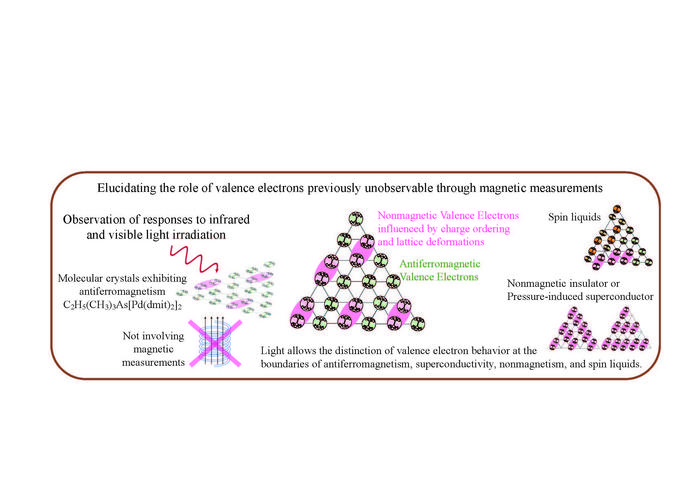Groundbreaking Study on Valence Electrons in Antiferromagnetic Molecular Crystals: Key Insights into Quantum Properties and Magnetism
In recent years, molecular crystals have become crucial in advancing our understanding of electronic behavior, particularly in terms of valence electrons and their relationship to phenomena like superconductivity and magnetism. A fascinating new study has elucidated the intricate dynamics of these electrons in a specific molecular crystal, revealing essential connections between structural characteristics and magnetic properties. The research employs advanced light techniques to probe the electron behavior, offering a deeper insight into the mechanisms driving these materials.
The study focuses on the molecular crystal (C₂H₅)(CH₃)₃As[Pd(C₃S₅)₂]₂, which is characterized by its unique triangular lattice structure. This arrangement allows for an innovative examination of valence electrons as they interact within a lattice framework, presenting an opportunity to explore how these interactions relate to both magnetic properties and potential applications in advanced quantum materials. The research team employed synchrotron infrared light along with near-infrared and visible lasers, enabling them to investigate the electron distribution with precision.
What makes this crystal particularly intriguing is its previously perceived magnetic nature. Initial hypotheses posited that all of its valence electrons contributed to the overall magnetic properties. However, the research team’s findings challenge this notion, indicating that a significant portion of these electrons contribute to a different state, forming pairs that exhibit phenomena more aligned with superconducting behavior rather than straightforward magnetism.
The meticulous analysis of how these valence electrons engaged with the lattice provided critical insights into their mobility and arrangement. By observing the electron distribution under various experimental conditions, the study revealed that about half of the valence electrons were tied up in non-magnetic pairs, rather than participating in magnetically active states. This unexpected discovery opens up new avenues for research into how non-magnetic electron states can influence superconductivity and other quantum phenomena.
The study’s implications are far-reaching, particularly in the context of ongoing explorations into quantum spin liquids—where electron spins remain disordered even at ultra-low temperatures. The electron arrangements depicted in the study closely mirrored configurations identified in such spin-liquid materials, suggesting that the properties of non-magnetic electrons could play a pivotal role in the development of future quantum technologies.
As the temperature of the crystal was systematically reduced during the experiments, the researchers noted a significant change in the electron pair formations. Initially, the pairs increased in number, indicative of interactions that favored magnetic states as thermal energy was removed from the system. Surprisingly, this accumulation of paired electrons did not lead to a straightforward increase in magnetism across the material; instead, a dynamic balance emerged where magnetic and non-magnetic states coexisted.
This delicate interplay of electron states challenges traditional views on magnetism within molecular crystals. The findings suggest that magnetically inactive electrons may harbor properties essential for understanding various quantum mechanical processes, including charge ordering phenomena which are relevant to superconductivity. Therefore, the research highlights the importance of considering all electron states when studying materials with the potential for advanced applications, such as in the fields of spintronics.
Consequently, this research provides an important step forward in the quest to uncover the underlying principles governing quantum materials. As researchers continue to investigate the connections between electron behavior and material properties, this study exemplifies the significant insights that can arise from focused studies on molecular crystals. By shedding light on the electron distribution and interactions within such structures, we gain deeper access to the mechanisms that drive emergent behaviors in quantum systems.
The methodological approach adopted by the research team exemplifies the power of modern spectroscopy techniques, integrating synchrotron infrared light and targeted laser applications to visualize phenomena that were previously elusive. The resultant data not only expands our understanding of electron dynamics within this specific molecular crystal but also sets a precedent for future investigations into the intricate relationships between lattice structures and quantum properties.
As these materials continue to be scrutinized, the potential for new discoveries looms large, particularly in the context of developing next-generation quantum technologies that could revolutionize computing, energy efficiency, and information storage. This research underscores the necessity of continued exploration into the mysterious world of molecular crystals, offering crucial insights that could lead to breakthroughs across various scientific domains.
In conclusion, this study heralds a new chapter in the exploration of quantum materials, illuminating the significant role that valence electrons play in shaping magnetic and electronic properties. As researchers delve deeper into these phenomena, one can only imagine the future discoveries that await—potentially paving the way for a new era in quantum science and technology.
Subject of Research: Valence electrons in antiferromagnetic molecular crystals
Article Title: Groundbreaking Study on Valence Electrons in Antiferromagnetic Molecular Crystals: Key Insights into Quantum Properties and Magnetism
News Publication Date: October 2023
Web References: DOI
References: Physical Review B
Image Credits: Takashi Yamamoto, Ehime University
Keywords
Molecular crystals
Valence electrons
Antiferromagnetism
Quantum properties
Superconductivity
Quantum spin liquids
Spectroscopy





